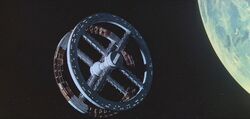Vi'Ix: Difference between revisions
No edit summary |
|||
| Line 45: | Line 45: | ||
== History == | == History == | ||
Vi'Ix was founded in 2751 ASC (Feb 16, 2007) when it officially achieved orbit around [[Micras]]. The space station's first module, now the heart of the Core, was built and launched by Universal Aerospace, the space program operated by the Technocracy of [[Universalis]]. The Universal space program was one of the most ambitious and earliest programs developed on Micras. The small technocracy had always been dedicated to the advancement of science and space exploration was no exception. The first components were launched from the spaceport of Tiberion in 2746, located in what is now the [[Skerry Isles]]. Mission 69 was the sixty-ninth operation undertaken by the space agency, with Colonel Taki Kawada given command of the station. By 2751 the station was operational with a small permanent crew of 24; the establishment of a permanent crew marks the official founding date of Vi'Ix. Over the next several years more modules and components were added to the station and the crew grew to around a hundred individuals. By 2800 Universalis began to collapse and be absorbed by [[Natopia]]. Then by 2850 the station was negotiating its own treaties with the Natopian Space Agency, having grown by leaps and bounds. | Vi'Ix was founded in 1525 [[AN]] / 2751 ASC (Feb 16, 2007) when it officially achieved orbit around [[Micras]]. The space station's first module, now the heart of the Core, was built and launched by Universal Aerospace, the space program operated by the Technocracy of [[Universalis]]. The Universal space program was one of the most ambitious and earliest programs developed on Micras. The small technocracy had always been dedicated to the advancement of science and space exploration was no exception. The first components were launched from the spaceport of Tiberion in 2746, located in what is now the [[Skerry Isles]]. Mission 69 was the sixty-ninth operation undertaken by the space agency, with Colonel Taki Kawada given command of the station. By 2751 the station was operational with a small permanent crew of 24; the establishment of a permanent crew marks the official founding date of Vi'Ix. Over the next several years more modules and components were added to the station and the crew grew to around a hundred individuals. By 2800 Universalis began to collapse and be absorbed by [[Natopia]]. Then by 2850 the station was negotiating its own treaties with the Natopian Space Agency, having grown by leaps and bounds. | ||
But political catastrophes on Micras put space exploration on hold by the turn of the millennium. As the year 3000 rolled around, communications between Vi'Ix and Micras had stopped completely. Fearing the worst and seeking to ensure its own safety, the station maintained a strict rule of no communication with the planet. Instead they began to develop small space tugs that could harvest resources from Micras' moon of [[Tarsica]] and from the asteroid field. Over the next several hundred years the Viixians developed mecha and more advanced spaceships capable of harvesting a greater amount of resources. At the same time, the space station continued expanding to accommodate population growth and the various modules needed to process resources, manufacture goods, and provide adequate life support. | But political catastrophes on Micras put space exploration on hold by the turn of the millennium. As the year 3000 rolled around, communications between Vi'Ix and Micras had stopped completely. Fearing the worst and seeking to ensure its own safety, the station maintained a strict rule of no communication with the planet. Instead they began to develop small space tugs that could harvest resources from Micras' moon of [[Tarsica]] and from the asteroid field. Over the next several hundred years the Viixians developed mecha and more advanced spaceships capable of harvesting a greater amount of resources. At the same time, the space station continued expanding to accommodate population growth and the various modules needed to process resources, manufacture goods, and provide adequate life support. | ||
Latest revision as of 15:28, 26 November 2024
| Super Fortress Vi'Ix Vi'Ix | |||
| |||
| Motto: Reach for the stars | |||
| Anthem: Space Oddity | |||

| |||
| Map versions | N/A | ||
| Capital | Kawada | ||
| Largest city | Star City | ||
| Official language(s) | English | ||
| Official religion(s) | Atheist | ||
| Demonym | Viixian | ||
| - Adjective | Viixian | ||
| Government | Oligarchy | ||
| - Commander | Hiroshi Tong | ||
| - Commander | None | ||
| - Legislature | Council | ||
| Establishment | 2751 ASC | ||
| Area | 58 mi² | ||
| Population | 2 million | ||
| Active population | 1 | ||
| Currency | Cy | ||
| Calendar | |||
| Time zone(s) | |||
| Mains electricity | |||
| Driving side | |||
| Track gauge | |||
| National website | None | ||
| National forum | Forum | ||
| National animal | Space Dragon | ||
| National food | Ice Cream | ||
| National drink | Asteroid Pop | ||
| National tree | Starflower | ||
| Abbreviation | VIX | ||
Vi'Ix, officially the Free State of Vi'Ix, and Super Fortress Vi'Ix, is an independent self-sustained space station orbiting Micras.
Etymology
The name Vi'Ix stems from the numeric designation of 69, which was the original name for the space mission when it was first constructed. Built by Universal Aerospace (as of 2019 Natopia) the station was the sixty-ninth mission to be launched by their space program. It became the only successful station to be launched and ultimately the last. The number however stuck and was picked up by the crew. Residents of the station still sometimes refer to themselves as "Sixtyniners".
History
Vi'Ix was founded in 1525 AN / 2751 ASC (Feb 16, 2007) when it officially achieved orbit around Micras. The space station's first module, now the heart of the Core, was built and launched by Universal Aerospace, the space program operated by the Technocracy of Universalis. The Universal space program was one of the most ambitious and earliest programs developed on Micras. The small technocracy had always been dedicated to the advancement of science and space exploration was no exception. The first components were launched from the spaceport of Tiberion in 2746, located in what is now the Skerry Isles. Mission 69 was the sixty-ninth operation undertaken by the space agency, with Colonel Taki Kawada given command of the station. By 2751 the station was operational with a small permanent crew of 24; the establishment of a permanent crew marks the official founding date of Vi'Ix. Over the next several years more modules and components were added to the station and the crew grew to around a hundred individuals. By 2800 Universalis began to collapse and be absorbed by Natopia. Then by 2850 the station was negotiating its own treaties with the Natopian Space Agency, having grown by leaps and bounds.
But political catastrophes on Micras put space exploration on hold by the turn of the millennium. As the year 3000 rolled around, communications between Vi'Ix and Micras had stopped completely. Fearing the worst and seeking to ensure its own safety, the station maintained a strict rule of no communication with the planet. Instead they began to develop small space tugs that could harvest resources from Micras' moon of Tarsica and from the asteroid field. Over the next several hundred years the Viixians developed mecha and more advanced spaceships capable of harvesting a greater amount of resources. At the same time, the space station continued expanding to accommodate population growth and the various modules needed to process resources, manufacture goods, and provide adequate life support.
In 3498 station astronomers first caught sight of the rogue planetoid Zimzim. Apparently the remnant of some former star system that had gone nova, the planet was in a free trajectory to pass close to the station within the next dozen years or so. The planet was a dead husk of a world, but the mass and gravitational force it exerted were enough to disrupt communications when it finally closed in on the station. What scientists did not anticipate was that the station itself had become large enough to exert its own gravity field and began to pull the rogue planet onto a crash course. In a desperate bid to ward off this impending armageddon, station scientists quickly developed magnetic anti-gravity devices (similar to those developed by the Flying Islands of Jasonia centuries earlier) in a bid to push the planet away. But the engines were only strong enough to keep the planet and station locked in a circuitous orbit of each other. With communications disrupted and all hands working fervently to keep Zimzim at bay, all attention was directed away from Micras, and the planet below forgot about the battle among the dark stars above. The stellar tug of war continued for another millennium before the station was able to finally develop technology adequate to push Zimzim away and back into a trajectory sending it off into another star system. Rumors abound that this was the star that slammed into Giess years later, but these claims have never been verified.
In 7100, more than four-thousand years after founding, Vi'Ix re-established contact with Micras, landing a small shuttle on the now-uninhabited island of Andromeda and re-opening radio communication with the surface nations. Several months later the MCS approved Vi'Ix claiming Andromeda (see Bell Rock for details) and officially re-opening the spaceport. Later that same year Vi'Ix debuted the grand opening of Farpoint Stadium, the first off-world sports arena for FMF games.
In 1675 AN a freak meteor storm shattered the station's communications array and disabled its shuttle bay, disrupting Vi'Ix's ability to both communicate with Micras and send teams to the surface. After nearly twenty years of work, using only materials on hand, the station was able to repair the damage and resume communications with Micras. But by this time the Andromeda Station had been destroyed and was now occupied by Batavia. As such the station has begun actively seeking a new location to establish a base on Micras which can be used as a waypoint station. In the interim, STAR forces successfully made a landing on Tarsica and have begun construction of a base there as another source of raw materials for the station.
Government and politics
As a space station established by military and scientific personnel, Vi'Ix operates as an oligarchy under the direction of dual monarchs, even though they do not designate themselves as such. This balance between science and military came about as the station was left to its own devices following the collapse of Universalis' space program. In order to appease both the military and scientific personnel, the commanders of each section agreed to a power-sharing government. Viixian politics tend to mimic the technocratic principles established by Universalis early on; wherein science and the advancement of humanity are considered paramount.
The two highest positions are the Chief Commanding Officer for the military, and the Chief Science Officer for researchers. Both positions have equal executive powers and share administration of the station. Unlike most political positions, these two officers must meet stringent educational and intellectual criteria, as well as showing significant contribution to the community. Once a pool of suitable nominees are screened the general public can vote to elect a favorite to the post. Every citizen over the age of 18 is eligible to vote in general elections.
Below the executive the state's legislature is called the Science Governing Board and functions much in the same role as a parliament. Science Officers are elected to the board for four year terms.
Political parties
There are five major political parties on Vi'Ix:
| Name | Ideology | Political position | |
|---|---|---|---|
| Crimson Skies Party | Social democracy, multiculturalism | Centre-left | |
| Interstellar Alliance | Classical liberalism, agrarianism | Centre | |
| Atos Party | Democratic socialism, environmentalism | Left-wing | |
| Starpride Party | Nationalism, protectionism | Right-wing | |
| Free Space Party | Conservatism, federalism | Centre-right | |
Foreign relations and military
STAR Troopers
The basic ground force - using the term broadly - is the STAR troopers (Space Tactical Assignment Regiments). They represent a small but integral part of the military that comprises security (including police), ground operations which includes off-world activities, and other basic duties that mechanized and/or armored units (such as MechForce) are simply not feasibly used. For example, the Andromeda Base on Micras is assigned two regiments of STAR troopers; around 4,000 soldiers. Other uses include policing the station and providing customs security.
MechForce
The Mechanized Robotic Forces, shortened to MechForce, is the armored forces of Vi'Ix. It became apparent early on that a large traditional military would not meet the needs of the space station. With the help of the scientific team, the Viixians developed mechanized robots (mecha) that could be piloted by a single person. Most mecha serve dual purposes, e.g. a combat mecha may swap out its armaments for agricultural implements to help grow crops in the foundation modules. This is often done in rotation so that the fortress is never left defenseless.
Due to the cost in both resources and economics, the number of mecha are very few. In fact, the numbers are so low that most are designated by personal names rather than model. As with other large units (e.g. an aircraft carrier or battleship being the top echelon of the navy) the mecha are considered the pinnacle of defense. Even repairs to these giant robotic suits are costly. Thus the military strives to maintain only the bare minimum necessary for defense, and to keep those units in pristine condition.
Besides the mecha, Vi'Ix maintains a small foot army of Star Marines trained in hand-to-hand combat. Of roughly equal size is the Star Fleet that essentially fills the role of a navy and oversees all armed spaceships (besides licensed mercenaries).
Starships
Vi'Ix has only two starships. One is a shuttle ship with launch and re-entry capabilities that can travel back and forth to Micras. The other is the SS Numenor, a modified freighter that has been upgraded to a frigate-style craft. The Numenor was originally discovered on Micras off the coast of Benacia and was subsequently raised and re-fitted by independent investors. It was eventually purchased by the Viixian government and is used primarily as an exploratory spacecraft.
Outreach Policies
Vi'Ix maintains a strict policy of neutrality and refuses to enter into any political alliances. The state is open to forging peace treaties with the nations of Micras and will foster trade deals with the land-based nations in an exchange of raw or otherwise difficult-to-produce items for technology and rare space minerals.
Foreign Relations
| Nation | Treaty | Status |
|---|---|---|
| Senya | none | Talks Initiated |
| Jingdao | none | none |
| Shireroth | none | none |
| Craitland | none | none |
| Natopia | none | Talks initiated |
Culture
After four millennia in space, the Viixians have developed a unique spacer culture that transcends racial, religious or other typical Micran typecasts. The original crew was composed of people from several Micran nations, including Shireroth, Natopia, Universalis, and more. Thus the current ethnic composition is really a mixture of all these groups. Over the centuries different sentient species (terrane in origin as no aliens species besides those of Tarsica and Hoenn have been discovered yet) have also added to the Viixian melting pot. Some species, such as the Tarsican polar worm, have been imported due to their resilience to harsh environments and have been adopted as livestock; in turn thriving in the station's artificial environment.
Demographics
The country has a total population of 1,979,825 citizens.
The following was the ethnic breakdown of the country, according to the 2019 census:
- Shirerithians: 221,857
- Natopians: 85,611
- Gralans: 77,200
- Universals: 150,000
- Nelagans: 10,515
- Craits: 97,272
- Batavians: 24,115
- Babkhans: 18,441
- Mixed race: 12,114
Economy
Vi'Ix uses a digital credit system that is completely electronic. Currency is known as Cy (short for cyber) and is stored in a central database maintained by the state. Each individual citizen is assigned a state-issued credit card that is coded to that specific person and that person alone. When a transaction is made, two cards can be connected (linked) together to transfer funds from one account to the other. The user has the option to select credit, wherein credit is issued from the holder's lender, or debit, which draws directly from their cash account. Electronic credit fraud and identity theft present the biggest challenges to use of the cy.
Resources
The major limitation of being a space station is access to natural resources. On the one hand, space is an endless supply of raw material; but accessing and harvesting those materials has proven, time and again, to be a daunting task. To provide for the needs of the station, the government undertook to implement the most efficient means of harvesting resources as possible. Transporting large quantities of resources from either Tarsica or Micras proved untenable due to the high cost of breaking gravity to get materials into orbit. Thus a more practical approach became necessary. Today the station uses a small fleet of space-going tugs that haul small asteroids from Atos' asteroid belt to the station where they are harnessed in a dry-dock of sorts and broken down into their component parts. These asteroids are not picked randomly. Often they are selected for composition wherein the majority of their components can be utilized somewhere on the station while producing minimal waste. For example, an asteroid may contain ice, ores, and a dirt/stone aggregate. The ice is melted down for water, ores smelted for metals, and dirt/stone added to the topsoil strata of habitat or agricultural modules. As such, almost none of the asteroid is wasted. Due to the hazards associated with towing an asteroid within close proximity of the station, only small asteroids that can be mechanically locked in stasis are towed. Larger asteroids are mined on site within the asteroid belt.
Construction
Rings
Vi'ix has two main rings that rotate around the central Core, thereby achieving artificial gravity. Each ring is approximately 1 mile wide and extends 14 miles in circumference.
The Core
The Core is not a ring but rather a spherical structure housing the main engines and the fusion reactor.
Powerhouse
The space station is powered by a combination of solar and nuclear. A large solar array provides all the electrical power the station requires. A gravimetric fusion reactor - based on Jasonian designs that were improved upon by Universalis - provides power to the Core and the engines. This includes the gravity engines that rotate the two rings and provide artificial gravity to the station, and the thruster engines that allow it to reposition within space.
The Inner Ring
The Inner Ring is completely dedicated to government functions. Central Command is a collection of administrative offices including the bridge. Other areas include an expansive training ground that is large enough to accommodate Mecha in simulated combat, a designated barracks area which provides housing for military personnel, the dockyards which provides ship repair (including dry-docks) and portage, and the Alpha and Beta quadrants that are designated for scientific research and personnel.
The Outer Ring
The Outer Ring houses most civilian activities, including the Ring Cities of the Habitation Module. Segueing into this is the Agricultural and Hydroponic modules. The former provides food for the station, while the latter contains a simulated freshwater ocean that provides water filtration, food and drinking water. The solar module is essentially a vast solar farm. Waste management provides recycling, which includes human byproducts. The factory module provides all manufacturing needs of the station. The research modules on this ring are limited to non-biological sciences (to limit potential outbreaks). The keystone module houses mechanics and engineering; essentially station maintenance.
Modules
Habitation
The Habitation module is a large section of the Outer Ring and occupies nearly a quarter of the total space. This is a broad section of the ring that has minimal obstructions, structural supports notwithstanding. The area was built with an underground support system to provide irrigation and fertilizer, and then top dressed with three meters of top soil so that grass and trees could be planted. The area was divided by government order into twenty-nine plots intended to be developed as individual communities. The two largest are Kawada, the state capitol, and Star City.
Factory
The factory module provides the industrial needs of the station and works in conjunction with the asteroid processing plant. Since towing massive space rocks into close proximity of the station was deemed hazardous and could potentially destabilize the artificial gravity, the asteroid processing plant is a mobile apparatus that essentially acts as a space-faring factory. The plant can attach to an asteroid where crews can begin mining and breaking it down into smaller rocks that can be safely transported back to the station. These smaller fragments are then processed in the factory module into their requisite components and then further used to manufacture whatever the station requires. Not all resources are available in space (or even readily accessible) so the station regularly makes stops on Tarsica and, less frequently, on Micras.
Foundation
Foundation modules are those modules that do not fit into the category of either habitat or factory. Nonetheless, they provide an essential function and are therefore considered the foundation of the station, as without them it could not function. A few examples include the Communications Module, Maintenance Module, Command Module and Waste Management Module.
Cities
Vi'Ix has a highly urban population, with nearly 2 million inhabitants living within the 30mi² of the habitation module. The two largest cities are Kawada and Star City.






